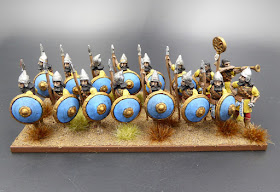These nine figures make up an Impetvs 'T' stand that can see service either independently or attached to a heavy infantry or "FP' unit. Figures are 28mm by Black Tree Design.
With six such bow stands in the project's arsenal, enough archers can now be fielded to support six heavy infantry stands. Six stands should be enough to fulfill any needs for Moorish archers. With two archers left in The Lead Pile, perhaps the remaining two stragglers will work themselves into an amalgamated unit at some point?















































